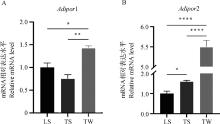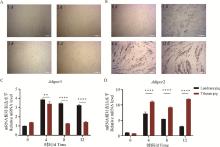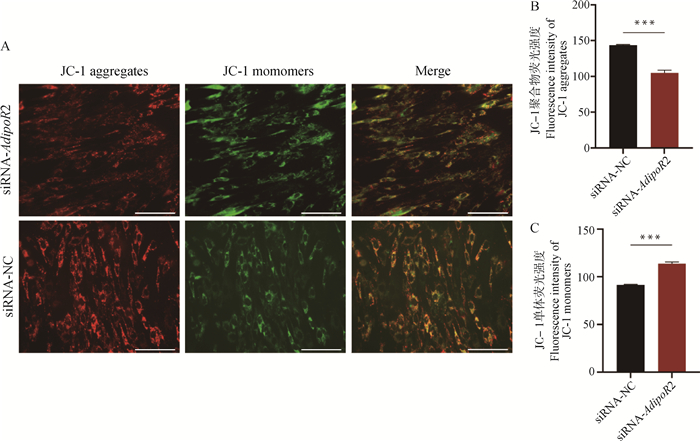





Acta Veterinaria et Zootechnica Sinica ›› 2025, Vol. 56 ›› Issue (6): 2649-2660.doi: 10.11843/j.issn.0366-6964.2025.06.011
• Animal Genetics and Breeding • Previous Articles Next Articles
LIU Siqi( ), YANG Zhen, YANG Yanan, CAI Yuan, ZHAO Shengguo*(
), YANG Zhen, YANG Yanan, CAI Yuan, ZHAO Shengguo*( )
)
Received:2024-11-28
Online:2025-06-23
Published:2025-06-25
Contact:
ZHAO Shengguo
E-mail:liusiqi231004@163.com;zhaosg@gsau.edu.cn
CLC Number:
LIU Siqi, YANG Zhen, YANG Yanan, CAI Yuan, ZHAO Shengguo. The Effect of Interfering with AdiopR2 on the Thermogenesis of Subcutaneous Inguinal Adipocytes in Tibetan Pigs[J]. Acta Veterinaria et Zootechnica Sinica, 2025, 56(6): 2649-2660.
Table 1
Primers information of RT-qPCR"
| 基因名 Gene symbol | 引物序列(5′→3′) Primers sequence | 产物长度/bp Products length | 退火温度/℃ Temperature |
| β-actin | F: CAGTCGGTTGGATGGAGCAT | 147 | 59.57 |
| R: AGGCAGGGACTTCCTGTAAC | |||
| Adipor1 | F: GGACAACGACTACCTGCTGCA | 82 | 61.41 |
| R: GTGGATGCGGAAGATGCTCT | |||
| Adipor2 | F: TCCTTCCGGGCCTGTTTTAAG | 233 | 59.46 |
| R: GAATGGCAGTAGACTGTGTGG | |||
| Cpt1-a | F: ATGCGCTACTCCCTGAAGGTG | 77 | 63.54 |
| R: GTGGCGCGGCTCATCTTGC | |||
| Fasn | F: CCGAGACCCTCGTGGGCTA | 209 | 63.28 |
| R: CTTCAGCAGGACGTTGAGGCC | |||
| Dio2 | F: ATGGGCATCCTCAGCGTAGAC | 151 | 63.89 |
| R: ACTCCCCGCGGGTGGACTT | |||
| Cidea | F: TTCCGAGTTTCCAACCACAA | 97 | 57.64 |
| R: CGATAACCAGGGCATCCAG | |||
| Ucp3 | F: AAGGTTCGATTCCAGGCCAG | 86 | 60.32 |
| R: GCGATGGTCCTGTAGGCATC | |||
| Atp2a2 | F: GGAACCCCTGCCACTTATCT | 190 | 59.67 |
| R: ATCGGTACATGCCGAGAACG | |||
| Atp5a1 | F: CGCCATTGATGGAAAGGGTC | 97 | 59.65 |
| R: TGGTTCCCGCACAGAGATTC | |||
| Ndufa1 | F: GCTCACATCCACAAGTTCACT | 90 | 57.32 |
| R: GCACCTATCTCTTTCCATCAAA | |||
| Sdha | F: TGGCATTTCTACGACACTGTG | 77 | 58.47 |
| R: GCCTGCTCTGTCATGTAGTG | |||
| Uqcrb | F: GGATGACGATGTAAAAGAAGCCA | 212 | 58.54 |
| R: TCTTTGCCCATTCTTCTCTTTCT |

Fig. 1
Adiponectin receptor gene expression levels increased after long-term cold exposure A. Relative mRNA expression level of Adipor1 in adipose tissue; B. Relative mRNA expression level of Adipor2 in adipose tissue. Statistical significance is denoted as P < 0.05 (*), P < 0.01(**), P < 0.001(**), P < 0.000 1(****), the same as below"


Fig. 2
Changes of adiponectin receptor gene expression during adipocyte differentiation in Tibetan pigs and Landrace pigs A. Tibetan pig preadipocytes images with a scale of 200 μm; B. Tibetan pig adipocyte images during adipogenic differentiation with a scale of 200 μm; C. Relative mRNA expression level of Adipor1 in adipocyte during adipogenic differentiation; D. Relative mRNA expression level of Adipor2 in adipocyte during adipogenic differentiation"


Fig. 4
siRNA-AdipoR2 inhibits AMPK signal A. Expression levels of p-AMPK, total AMPK, p-ACC, total ACC, and the reference protein β-Tubulin in adipocytes; B. Quantification of experimental results using grayscale analysis with ImageJ software; C. Relative mRNA expression level of Cpt1-a in adipocytes"


Fig. 7
Determination of mitochondrial membrane potential in Tibetan pig adipocytes A. Representative JC-1 fluorescent staining images were taken with the same fluorescence intensity and the scale length of 100 μm; B. Quantitative analysis of JC-1 aggregate fluorescence intensity; C. Quantitative analysis of JC-1 monomer fluorescence intensity"

| 1 |
BERG F , GUSTAFSON U , ANDERSSON L . The uncoupling protein 1 gene (UCP1) is disrupted in the pig lineage: A genetic explanation for poor thermoregulation in piglets[J]. PLoS Genet, 2006, 2 (8): e129.
doi: 10.1371/journal.pgen.0020129 |
| 2 | 陈华. 藏猪在青藏高原独特生态环境下的养殖适应性研究[J]. 畜牧业环境, 2023 (20): 99- 101. |
| CHEN H . Study on Tibetan pig breeding adaptability in Qinghai-Tibet Plateau's unique ecology[J]. Animal Industry and Environment, 2023 (20): 99- 101. | |
| 3 |
LIN J , CAO C , TAO C , et al. Cold adaptation in pigs depends on UCP3 in beige adipocytes[J]. J Mol Cell Biol, 2017, 9 (5): 364- 375.
doi: 10.1093/jmcb/mjx018 |
| 4 | 李倩文, 杨榛, 杨雅楠, 等. 冬夏两季环境温度对藏猪生理特征及相关基因表达的影响[J]. 中国畜牧兽医, 2021, 48 (3): 873- 881. |
| LI Q W , YANG Z , YANG Y N , et al. Effects of environmental temperature in winter and summer on physiological characteristics and related gene expression of Tibetan pigs[J]. China Animal Husbandry & Veterinary Medicine, 2021, 48 (3): 873- 881. | |
| 5 |
STRAUB L G , SCHERER P E . Metabolic messengers: Adiponectin[J]. Nat Metab, 2019, 1 (3): 334- 339.
doi: 10.1038/s42255-019-0041-z |
| 6 |
ACHARI A E , JAIN S K . Adiponectin, a therapeutic target for obesity, diabetes, and endothelial dysfunction[J]. Int J Mol Sci, 2017, 18 (6): 1321.
doi: 10.3390/ijms18061321 |
| 7 |
OKADA-IWABU M , YAMAUCHI T , IWABU M , et al. A small-molecule AdipoR agonist for type 2 diabetes and short life in obesity[J]. Nature, 2013, 503 (7477): 493- 499.
doi: 10.1038/nature12656 |
| 8 |
IWABU M , OKADA-IWABU M , TANABE H , et al. AdipoR agonist increases insulin sensitivity and exercise endurance in AdipoR-humanized mice[J]. Commun Biol, 2021, 4 (1): 45.
doi: 10.1038/s42003-020-01579-9 |
| 9 |
ZHANG S , WU X , WANG J , et al. Adiponectin/AdiopR1 signaling prevents mitochondrial dysfunction and oxidative injury after traumatic brain injury in a SIRT3 dependent manner[J]. Redox Biol, 2022, 54, 102390.
doi: 10.1016/j.redox.2022.102390 |
| 10 |
SONG N , XU H , WU S , et al. Synergistic activation of AMPK by AdipoR1/2 agonist and inhibitor of EDPs-EDP interaction recover NAFLD through enhancing mitochondrial function in mice[J]. Acta Pharm Sin B, 2023, 13 (2): 542- 558.
doi: 10.1016/j.apsb.2022.10.003 |
| 11 |
XU H , ZHAO Q , SONG N , et al. AdipoR1/AdipoR2 dual agonist recovers nonalcoholic steatohepatitis and related fibrosis via endoplasmic reticulum-mitochondria axis[J]. Nat Commun, 2020, 11 (1): 5807.
doi: 10.1038/s41467-020-19668-y |
| 12 |
HAN Y , SUN Q , CHEN W , et al. New advances of adiponectin in regulating obesity and related metabolic syndromes[J]. J Pharm Anal, 2024, 14 (5): 100913.
doi: 10.1016/j.jpha.2023.12.003 |
| 13 |
HERZIG S , SHAW R J . Ampk: Guardian of metabolism and mitochondrial homeostasis[J]. Nat Rev Mol Cell Biol, 2018, 19 (2): 121- 135.
doi: 10.1038/nrm.2017.95 |
| 14 |
REISMAN E G , HAWLEY J A , HOFFMAN N J . Exercise-regulated mitochondrial and nuclear signalling networks in skeletal muscle[J]. Sports Med, 2024, 54 (5): 1097- 1119.
doi: 10.1007/s40279-024-02007-2 |
| 15 |
STEINBERG G R , HARDIE D G . New insights into activation and function of the AMPK[J]. Nat Rev Mol Cell Biol, 2023, 24 (4): 255- 272.
doi: 10.1038/s41580-022-00547-x |
| 16 |
WU G , BAUMEISTER R , HEIMBUCHER T . Molecular mechanisms of lipid-based metabolic adaptation strategies in response to cold[J]. Cells, 2023, 12 (10): 1353.
doi: 10.3390/cells12101353 |
| 17 |
IMBEAULT P , DéPAULT I , HAMAN F . Cold exposure increases adiponectin levels in men[J]. Metabolism, 2009, 58 (4): 552- 559.
doi: 10.1016/j.metabol.2008.11.017 |
| 18 | MENGEL L A , SEIDL H , BRANDL B , et al. Gender differences in the response to short-term cold exposure in young adults[J]. J Clin Endocrinol Metab, 2020, 105 (5): dgaa110. |
| 19 |
HUI X , GU P , ZHANG J , et al. Adiponectin enhances cold-induced browning of subcutaneous adipose tissue via promoting M2 macrophage proliferation[J]. Cell Metab, 2015, 22 (2): 279- 290.
doi: 10.1016/j.cmet.2015.06.004 |
| 20 |
唐妮, 王书瑶, 齐锦雯, 等. 脂联素调控脂质代谢的研究进展[J]. 畜牧兽医学报, 2018, 49 (12): 2550- 2557.
doi: 10.11843/j.issn.0366-6964.2018.12.003 |
|
TANG N , WANG S Y , QI J W , et al. Research progress on adiponectin regulating lipid metabolism[J]. Acta Veterinaria et Zootechnica Sinica, 2018, 49 (12): 2550- 2557.
doi: 10.11843/j.issn.0366-6964.2018.12.003 |
|
| 21 |
WANG Y , LIANG B , LAU W B , et al. Restoring diabetes-induced autophagic flux arrest in ischemic/reperfused heart by ADIPOR (adiponectin receptor) activation involves both AMPK-dependent and AMPK-independent signaling[J]. Autophagy, 2017, 13 (11): 1855- 1869.
doi: 10.1080/15548627.2017.1358848 |
| 22 |
BAUZÁ-THORBRVGGE M , VUJIČI Ć M , CHANCLÓN B , et al. Adiponectin stimulates Sca1+CD34--adipocyte precursor cells associated with hyperplastic expansion and beiging of brown and white adipose tissue[J]. Metabolism, 2024, 151, 155716.
doi: 10.1016/j.metabol.2023.155716 |
| 23 |
NGUYEN T M D . Adiponectin: Role in physiology and pathophysiology[J]. Int J Prev Med, 2020, 11, 136.
doi: 10.4103/ijpvm.IJPVM_193_20 |
| 24 |
GHADGE A A , KHAIRE A A , KUVALEKAR A A . Adiponectin: A potential therapeutic target for metabolic syndrome[J]. Cytokine Growth Factor Rev, 2018, 39, 151- 158.
doi: 10.1016/j.cytogfr.2018.01.004 |
| 25 |
KADOWAKI T , YAMAUCHI T , KUBOTA N , et al. Adiponectin and adiponectin receptors in insulin resistance, diabetes, and the metabolic syndrome[J]. J Clin Invest, 2006, 116 (7): 1784- 1792.
doi: 10.1172/JCI29126 |
| 26 |
ZHAO Y , SUN N , SONG X , et al. A novel small molecule AdipoR2 agonist ameliorates experimental hepatic steatosis in hamsters and mice[J]. Free Radic Biol Med, 2023, 203, 69- 85.
doi: 10.1016/j.freeradbiomed.2023.04.001 |
| 27 |
PAHLAVANI H A , LAHER I , WEISS K , et al. Physical exercise for a healthy pregnancy: The role of placentokines and exerkines[J]. J Physiol Sci, 2023, 73 (1): 30.
doi: 10.1186/s12576-023-00885-1 |
| 28 |
KHORAMIPOUR K , CHAMARI K , HEKMATIKAR A A , et al. Adiponectin: Structure, physiological functions, role in diseases, and effects of nutrition[J]. Nutrients, 2021, 13 (4): 1180.
doi: 10.3390/nu13041180 |
| 29 |
CHEN S , LIU X , PENG C , et al. The phytochemical hyperforin triggers thermogenesis in adipose tissue via a Dlat-AMPK signaling axis to curb obesity[J]. Cell Metab, 2021, 33 (3): 565- 580.e7.
doi: 10.1016/j.cmet.2021.02.007 |
| 30 | LIU J , WANG Y , LIN L . Small molecules for fat combustion: Targeting obesity[J]. Acta Pharm Sin B, 2019, 9 (2): 220- 236. |
| 31 | DENG Y , HAN Y , GAO S , et al. The physiological functions and polymorphisms of type Ⅱ deiodinase[J]. Endocrinol Metab (Seoul), 2023, 38 (2): 190- 202. |
| 32 | ZHOU Z , YON TOH S , CHEN Z , et al. Cidea-deficient mice have lean phenotype and are resistant to obesity[J]. Nat Genet, 2003, 35 (1): 49- 56. |
| 33 | OLIVERAS-CAñELLAS N , MORENO-NAVARRETE J M , LORENZO P M , et al. Downregulated adipose tissue expression of browning genes with increased environmental temperatures[J]. J Clin Endocrinol Metab, 2023, 109 (1): e145- e154. |
| 34 | JASH S , BANERJEE S , LEE M J , et al. CIDEA transcriptionally regulates UCP1 for britening and thermogenesis in human fat cells[J]. iScience, 2019, 20, 73- 89. |
| 35 | KIM M , PAIK J H , LEE H , et al. Ancistrocladus tectorius extract inhibits obesity by promoting thermogenesis and mitochondrial dynamics in high-fat diet-fed mice[J]. Int J Mol Sci, 2024, 25 (7): 3743. |
| 36 | GOTTSCHALK B , KOSHENOV Z , MALLI R , et al. Implications of mitochondrial membrane potential gradients on signaling and ATP production analyzed by correlative multi-parameter microscopy[J]. Sci Rep, 2024, 14 (1): 14784. |
| [1] | YAO Boyuan, YANG Zhiwen, SUN Yapeng, YANG Yanan, ZHANG Yaru, WANG Xinrong. Analysis of Novel Transcripts, Alternative Splicing, and SNP in Porcine Heart Tissue Based on RNA-Seq Technology [J]. Acta Veterinaria et Zootechnica Sinica, 2025, 56(4): 1664-1675. |
| [2] | HOU Wanchen, XU Tong. Cannabidiol Antagonizes BPA-induced Apoptosis and Autophagy in Porcine Intestinal Epithelial Cells through the BRD4/AMPK/mTOR Signaling Pathway [J]. Acta Veterinaria et Zootechnica Sinica, 2025, 56(4): 1919-1933. |
| [3] | YANG Yuting, CHEN Guoliang, CHANG Qiaoning, BAO Wu, LIU Jingchao, JI Mengting, RONG Xiaoyin, GUO Xiaohong, YANG Yang, LI Bugao. miR-375-3p Targets Fam229a to Regulate Porcine Precursor Adipocyte Differentiation [J]. Acta Veterinaria et Zootechnica Sinica, 2025, 56(3): 1120-1133. |
| [4] | ZHAO Gangkui, GAO Haixu, YIN Siqi, SUN Honghong, XIN Yiran, ZAN Linsen, ZHAO Chunping. The Effects of the SFRP4 Gene on Bovine Preadipocyte Differentiation [J]. Acta Veterinaria et Zootechnica Sinica, 2025, 56(2): 611-620. |
| [5] | Yi WANG, Juan GAO, Yuemin HU, Yuefei YANG, Bojun FAN, Huiming JU. Effect of Transient Serum Starvation on Metabolism and Autophagy of Porcine Skeletal Muscle Satellite Cells [J]. Acta Veterinaria et Zootechnica Sinica, 2024, 55(8): 3408-3417. |
| [6] | Yao LI, Rui JIA, Jie LI, Shuangbao GUN, Qiaoli YANG, Longlong WANG, Pengxia ZHANG, Xiaoli GAO, Xiaoyu HUANG. Effects of Low Temperature on Adipose Tissue Morphology, Lipid Metabolism-Related Gene Expression and Enzyme Activities, and AMPK/PGC-1α Pathway in Hezuo Pigs [J]. Acta Veterinaria et Zootechnica Sinica, 2024, 55(8): 3418-3426. |
| [7] | Xiaojuan LIANG, Yushuang LI, Zhou FU, Duo TANG, Yingying LI, Shouwei WANG. Isolation, Culture and Adipogenic Differentiation of Pigeon Preadipocytes [J]. Acta Veterinaria et Zootechnica Sinica, 2024, 55(8): 3482-3492. |
| [8] | Ya’nan LI, Tianwen MA, Yuhui MA, Chengwei WEI. Bilobalide Regulates Mitochondrial Biogenesis Mediated by AMPK-SIRT3 Positive Feedback Loop and Improves Inflammatory Damage of ATDC5 Chondrocytes [J]. Acta Veterinaria et Zootechnica Sinica, 2024, 55(8): 3714-3724. |
| [9] | Xiaojuan LIANG, Yushuang LI, Yingying LI, Shouwei WANG. Isolation, Culture and Adipogenic Differentiation of Beijing Black Pig Preadipocytes [J]. Acta Veterinaria et Zootechnica Sinica, 2024, 55(7): 2877-2889. |
| [10] | SUN Wenli, WANG Haoqi, ZE Licuo, GAO Yufan, ZHANG Feifan, ZHANG Jian, DUAN Mengqi, SHANG Peng, QIANG Bayangzong. Polymorphism of Pro-Inflammatory Factors (IL-1β, IL-6, TNF-α) in Tibetan Pigs and Its Association Analysis with Immune Traits [J]. Acta Veterinaria et Zootechnica Sinica, 2024, 55(5): 1958-1969. |
| [11] | Weiyu ZHANG, Jing CHENG, Jiabao XU, Jing WANG, Xinyan TAO, Bo LI, Yawei ZHANG, Dandan ZHANG, Ning ZHANG, Zhenkai HAO, Chenbo ZHOU, Yuanqing ZHANG. Regulation of Preadipocyte Differentiation by SREBP1 Gene in Jinnan Cattle [J]. Acta Veterinaria et Zootechnica Sinica, 2024, 55(11): 5003-5017. |
| [12] | Yao TANG, Tao WANG, Mengqing XUE, Wenyu ZHANG, Mei SHI, Xianzhong WANG, Jiaojiao ZHANG. Thiazolidinedione Inhibits Chicken Growth via Adiponectin-mediated AMPK Signaling Pathway [J]. Acta Veterinaria et Zootechnica Sinica, 2024, 55(11): 5247-5258. |
| [13] | Lan FENG, Xue FENG, Yulin MA, Lingkai ZHANG, Yanfen MA, Dawei WEI, Fen LI, Lupei ZHANG, Runjun YANG, Yun MA, Bei CAI. Study on the Function of PPP5C Gene in Regulating the Proliferation and Differentiation of Bovine Adipocytes [J]. Acta Veterinaria et Zootechnica Sinica, 2024, 55(10): 4391-4402. |
| [14] | TANG Yinmei, LI Qi, LI Haiyang, LIN Yaqiu, WANG Yong, XIANG Hua, HUANG Lian, ZHU Jiangjiang. Cloning of the Goat FATP2 Gene and Its Regulatory Effect on Lipid Deposition in Precursor Adipocytes [J]. Acta Veterinaria et Zootechnica Sinica, 2023, 54(9): 3642-3652. |
| [15] | SHAO Peng, TANG Yinmei, LIN Yaqiu, WANG Yong, XIANG Hua, HUANG Lian, ZHU Jiangjiang. Regulation Effect of PSMD9 on Lipid Deposition in Goat Precursor Adipocytes [J]. Acta Veterinaria et Zootechnica Sinica, 2023, 54(9): 3653-3663. |
| Viewed | ||||||
|
Full text |
|
|||||
|
Abstract |
|
|||||